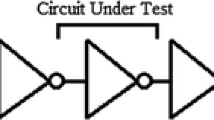Abstract
A novel single-ended SRAM is proposed in this study, where the built-in self-refleshing data retention path has been utilized to reduce the SRAM cell area. In order to reduce the power-delay product, an analytical solution to derive the optimal number of the 5T cells on the BLB is reported in this paper. The proposed SRAM is implement by TSMC 90 nm CMOS technology. According to the measurement results, the energy dissipation per write/read operation is found to be 0.479/0.091 fJ provided that the SRAM cells is supplied a 0.6 V VDD supply.













Similar content being viewed by others
References
Wang, C.-C., Tseng, Y.-L., Leo, H.-Y., & Hu, R. (2004). A 4-Kb 500-MHz 4-T CMOS SRAM using low-\(V_{THN}\) bitline drivers and high-\(V_{THP}\) latches. IEEE Transactions on Very Large Scale Integration (VLSI) Systems, 12(9), 901–909.
Wang, C.-C., Lee, C.-L., & Lin, W.-J. (2007). A 4-Kb low power SRAM design with negative word-line scheme. IEEE Transactions on Circuits & Systems I : Regular Papers, 54(5), 1069–1076.
Wang, C.-C., Sung, G.-N., Lee, C.-L., Chen, T.-H., Lin, W.-J., & Hu, R. (2008). 1.7-ns access time SRAM using wordline-controlled transistors with variable bulk bias. Journal of Circuits, Systems, and Computers (JCSC), 17(5), 943–956.
Yang, B.-D. (2010). A low-power SRAM using bit-line charge-recycling for read and write operations. IEEE Journal of Solid-State Circuits, 43(2), 2173–2183.
Morifuji, E., Yoshida, T., Kanda, M., Matsuda, S., Yamada, S., & Matsuoka, F. (2006). Supply and threshold-voltage trends for scaled logic and SRAM MOSFETs. IEEE Transactions on Electron Devices, 53(6), 1427–1432.
Seevinck, E., List, F. J., & Lohstroh, J. (1987). Static-noise margin analysis of MOS SRAM cells. IEEE Journal of Solid-State Circuits, SC–22(5), 748–754.
Makino, H., Nakata, S., Suzuki, H., Mutoh, S., Miyama, M., Yoshimura, T., et al. (2012). Utilising the normal distribution of the write noise margin to easily predict the SRAM write yield. IET Circuits, Devices & Systems, 6(4), 260–270.
Vaalaee, A., & Al-Khalili, A. J. (2012). High-performance low-power sensing scheme for nanoscale SRAMs. IET Computers & Digital Techniques, 6(6), 406–413.
Chen, S.-Y., & Wang, C.-C. (May 2012). Single-ended disturb-free 5T loadless SRAM cell using 90 nm CMOS process. In IEEE international conference on IC design and technology (pp. 1–4).
Al-Harbi, S., & Gupta, S. (April 2001). An efficient methodology for generating optimal and uniform march tests. In Proceedings of IEEE VLSI test symposium (pp. 231–237).
Chiu, Y.-W., Hu, Y.-H., & Tu, M.-H. (2014). 40 nm bit-interleaving 12T subthreshold SRAM with data-aware write-assist. IEEE Transactions on Circuits and Systems I: Regular Papers, 61(9), 2578–2585.
Lien, N.-C., Chu, L.-W., Chen, C.-H., & Yang, H.-I. (2014). A 40 nm 512 kb cross-point 8 T pipeline SRAM with binary word-line boosting control, ripple bit-line and adaptive data-aware write-assist. IEEE Transactions on Circuits and Systems I: Regular Papers, 61(12), 3416–3425.
Yang, Y., Juhyun, P., Song, S.-C., Wang, J., Geoffrey, Y., & Jung, S.-O. (2015). Single-ended 9T SRAM cell for near-threshold voltage operation with enhanced read performance in 22-nm FinFET technology. IEEE Transactions on Very Large Scale Integration (VLSI) Systems, 23(11), 2748–2752.
Wang, C.-C., Wang, D.-S., & Liao, C.-H. (2015). A leakage compensation design for low supply voltage SRAM. IEEE Transactions on Very Large Scale Integration (VLSI) Systems, 24(5), 1761–1769.
Yang, Y., Juhyun, P., Song, S.-C., Wang, J., Geoffrey, Y., & Jung, S.-O. (May 2016) A 17.5-fJ/bit energy-efficient analog SRAM for mixed-signal processing. In IEEE international symposium on circuits and systems (pp. 22–25).
Acknowledgements
This investigation is partially supported by Ministry of Science and Technology under Grant MOST 104-2622-E-006-040-CC2, MOST 105-2218-E-110-006, and MOST 105-2-E-110-058. The authors would like to express their deepest gratefulness to Chip Implementation Center of National Applied Research Laboratories, Taiwan, for their thoughtful chip fabrication service and EDA tool support. The authors also like to thank Mr. C.-H. Liao for his assistance in the physical measurement of the SRAM chips.
Author information
Authors and Affiliations
Corresponding author
Rights and permissions
About this article
Cite this article
Wang, CC., Wang, DS. & Chen, SY. 56.67 fJ/bit single-ended disturb-free 5T loadless 4 kb SRAM using 90 nm CMOS technology. Analog Integr Circ Sig Process 96, 435–443 (2018). https://doi.org/10.1007/s10470-018-1186-5
Received:
Revised:
Accepted:
Published:
Issue Date:
DOI: https://doi.org/10.1007/s10470-018-1186-5




